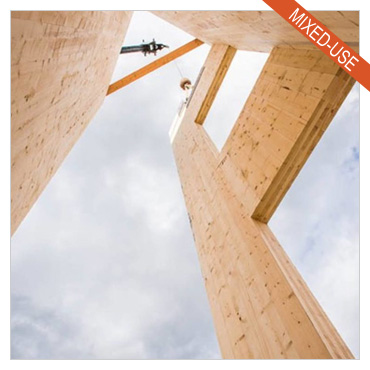|
BRIEFLY… |
|
|
|
|
|
Sponsored
|
|
|
|
Sponsored
|
|
|
|
|
|
FORM + FUNCTION |
 |
A multi-use, multi-level building currently under construction in Whitefish, Montana, will feature an elevator shaft manufactured from cross-laminated timber (CLT) rather than the traditional choice of concrete masonry units (CMUs). This elevator shaft—the first in the country to be made from CLT—will be 14 m (45 ft) tall on completion. The engineered wood technology—which will be a focus in the forthcoming February 2017 issue of The Construction Specifier—comprises several layers of lumber boards, stacked crosswise and bonded.
|
|
|
LAW
The doctrine of privity in the common law of contract protects architects and engineers from lawsuits by contractors by requiring that for one party to sue another, there must be a contract between them. However, recent developments in tort law have weakened this defense by providing a path for contractors to sue architects and engineers for financial losses resulting from negligent misinformation in the construction documents. An obvious way to prevent this is to have a clear, complete, correct, and concise set of construction documents and ensure the contractor’s bid likewise follows the Four Cs. The post-bid interview is the last opportunity to examine the contractor’s bid before a contract is signed.
|
|
EVENTS
January 10-12, 2017
International Builders’ Show
National Association of Home Builders
Orlando, Florida
www.buildersshow.com
January 18-20, 2017
The International Surface Event
Informa
Las Vegas, Nevada
tisewest.com
January 28-February 1, 2017
ASHRAE Conference/AHR Expo
American Society of Heating, Refrigerating, and Air-conditioning Engineers
Las Vegas, Nevada
www.ashrae.org
January 29-February 1, 2017
Sprayfoam 2017 Convention & Expo
Spray Polyurethane Foam Alliance (SPFA)
Palm Springs, California
www.sprayfoam.org/expo
February 12-15, 2017
AAMA 80th Annual Conference
American Architectural Manufacturers Association
Phoenix, Arizona
www.aamanet.org/events
|
|
|
VIEW LATEST ISSUE

|
|
TOP TRENDING ARTICLES |
Federal, state, and local specifiers continually seek affordable, durable, and aesthetically pleasing wall solutions to border bustling highways and adjacent neighborhoods. The principal purpose of these is typically to provide citizens with a visual barrier to the highway and sometimes to mitigate traffic noise. Today, highway barriers cover thousands of miles of federal roadways. When the walls first began to appear in the 1960s, they were modeled after wooden fences. Now, things have changed––according to the Federal Highway Administration (FHWA), almost half of the highway walls constructed in North America to date are made of concrete. That material meets many affordability, durability, and aesthetic specifications and preferences.
|
All over the United States, a hard truth is being uncovered—underneath carpet and vinyl tile in buildings everywhere, there lurks ugly concrete. With acceptance of exposed concrete floors on the rise, and remodeling continuing to dominate the construction market, plans to polish existing concrete subfloors are numerous. However, some slabs are simply not up to the challenge.
 READ MORE READ MORE
|
Observations of numerous building envelope failures in stucco (i.e. Portland cement plaster) indicate it may lack durability when correct installation practices are not performed. One of the most common problems is cracked stucco—and with the increasing trend of using the material as a cladding, the situation will likely get worse.
|
Clear-span aluminum structures and temporary steel buildings have advanced over the years. Knowing when to use them is a skill worth mastering for construction specifiers, procurement professionals, and facility managers. Familiarity with specific spaces, and knowing the assemblies’ framework of costs and benefits, may also help designers and specifiers incorporate them into their own sites and make optimal recommendations.
|
|
|
|
|
|

